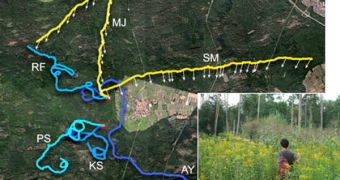As hinted at in books, folklore tales and scary movies, people seem to actually have the tendency of walking in circles when they are lost, or when they do not have any landmarks nearby to guide them on the correct path. The new study was conducted by a team of experts from the Max Planck Institute for Biological Cybernetics, in Tubingen, Germany, who were led by psychologist Jan Souman. The scientist is also the first author of the investigation.
Souman's team is experienced in studying perception and action, and it was contacted by the producers of a reality show for the new research. It had received a question from its audience, as to whether it was true people who were lost walked in circles. “We didn't really know, but we thought it was an interesting question,” the scientist says, quoted by ScienceNow. So, a number of experiments was devised, aimed at seeing whether people, indeed, walked in circular patterns rather than straight ahead.
Some 15 test participants were blindfolded in one experiment, and outfitted with GPS receivers, and then sent to walk in a straight line across a field. Some of them managed to achieve this objective, although they too deviated from their original course considerably. But a number of volunteers walked in circles as small as 20 meters. Previous attempts at explaining this behavior have it that it's the length of the feet that causes this to happen, as, in all people, one of their feet is shorter than the other.
In an attempt to disprove this, the German team exaggerated the natural length difference between the feet, and made some participants wear a 12-millimeter-thick-sole shoe in just one foot. No clear correlation between adding the sole and a larger tendency of walking in circles was discovered, the experts say. Their complete results appear in the latest online issue of the scientific journal Current Biology.
The team proposes that the human brain plays an important role in preventing this from happening, in the sense that walking blindfolded deprives it of a large number of sensory inputs. When participants were made to walk in a straight line in a forest, and then again in the Sahara desert, without any cover on their eyes, they showed an increased level of accuracy in keeping to a straight line. Changes in direction appeared in the forests, but only on clouded days, when the Sun was not directly visible.

 14 DAY TRIAL //
14 DAY TRIAL //